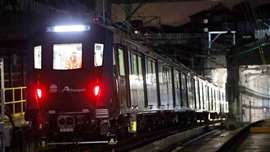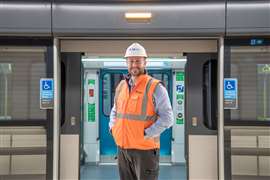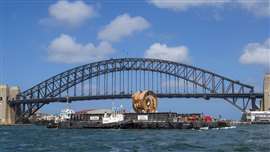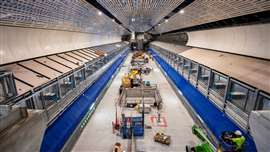Read this article in French German Italian Portuguese Spanish
Down Under: The challenges of building Sydney’s mega metro
30 July 2024
The latest phase of Sydney’s multi-billion dollar metro system is set to open this summer, allowing passengers to whizz under the city’s iconic harbour in driverless trains in a matter of seconds. Josh Watkin, Sydney Metro head of delivery, tells Lucy Barnard about the construction challenges his teams have faced building it.
With a single toot of its horn, the sleek, white, driverless metro train slides slowly away from Victoria Cross station in Sydney before seamlessly accelerating and racing under the city’s famous harbour at speeds of up to 100 kilometres per hour.
Welcome to the latest phase of Sydney’s new Metro megaproject, due to open to passengers on Sunday with turn-up-and-go computer driven trains crossing the world’s largest natural harbour every four minutes in peak periods.
 Train testing on the network. Photo: Sydney Metro
Train testing on the network. Photo: Sydney Metro
Designed to better connect north and south Sydney which are cut off from each other by the harbour and ease congestion in Australia’s most crowded city, Sydney Metro is one of the world’s biggest suburban rail projects.
“Sydney Metro is Australia’s biggest public transport project and is revolutionising how Australia’s biggest city travels,” says Josh Watkin, head of project delivery at Sydney Metro, who leads a 220-strong team responsible for key elements of these projects including cost estimating, cost management, planning and programming, risk management and reporting.
“Metro is a turn-up-and-go service. With a train every four minutes in the peak in each direction, there is no timetable - people can just turn up, catch the next metro train and be on their way to their destination.”
A former officer in the Royal Australian Navy with a master’s degree in Peace and Conflict studies from the University of Sydney, Watkin joined the Sydney Metro project back in 2015 as a director for strategy and governance and, in the nearly a decade since, has worked across pretty much every element of the project.
Tunnelling under Sydney Harbour
One of the biggest engineering challenges of delivering Sydney Metro through the city, he says, was how to get under the harbour, which forms a bottleneck.
Before the Metro tunnel, the only way to cross the harbour was the iconic 1930s-built Sydney Harbour Bridge and the Sydney Harbour Tunnel dual carriageway which was completed in 1992.
Moreover, as Sydney Harbour Tunnel is an immersed tube tunnel, sitting in a trench in the seabed, the metro tunnels were the first in the Australian city to be drilled into the sandstone, clay, silt and sediment under the harbour, reaching 40 meters below sea level at their lowest point.
 Josh Watkin, Sydney Metro head of project delivery. Photo: Sydney Metro
Josh Watkin, Sydney Metro head of project delivery. Photo: Sydney Metro
Construction teams used a specially-designed 975-tonne mixshield Herrenknecht tunnel boring machine named Kathleen to cope with the high pressures while, before they could start work, her 50-strong crew had to undergo training in a hyperbaric chamber simulating the conditions observed by a doctor.
After injecting high grade cement into the sandstone to stop water seeping through the bedrock, Kathleen’s crew drilled first one 884 meter-long passage from the new Barangaroo metro station to Blues Point in 2019 before the machine was pulled back along the same route and set to work drilling a second 884 meter-long twin close by.
“It was the first time railway tunnels were built under Sydney Harbour, which required specialised TBMs for the unique geological conditions under Sydney Harbour,” says Watkin.
Another of the headline grabbing engineering feats included in the construction of the megaproject has been the creation of Australia’s largest underground railway cavern.
The cavern at Victoria Cross station in north Sydney is 300 meters long, 25 meters wide and 16 meters high. By contrast, St Peter’s in the Vatican, the largest church in the world, measures just 218 meters in length.
Australia’s largest station cavern
The station was difficult to build because the land above it lies uphill compared with the harbour which is 1.5 kilometres away. Design teams were caught on the horns of a dilemma: Build the station deep enough to reduce the gradient of the track between the harbour and the station, which would have meant that station had to be built up to 60 meters below the surface – too deep to install escalators. Or re-route the metro line. In the end the teams chose to re-route and build an additional station at Barangaroo, leaving Victoria Cross just 31 meters beneath street level.
Construction of the cavern started in 2021 and took a team of more than 5,000 people three years to deliver, design and construct.
Added to this, Watkin and his teams have had to deal with the additional chalenge of constructing Australia’s biggest public transport underneath the country’s bustling financial and economic hub.
In order to minimise disruption and reduce carbon emissions, construction teams removed spoils via barge across the harbour, station construction was staggered to reduce traffic congestion and acoustic sheds were used to contain noise on a number of work sites.
 TBM Kathleen’s front shield and cutter head being transported back across Sydney Harbour by barge in 2020. Photo: Sydney Metro
TBM Kathleen’s front shield and cutter head being transported back across Sydney Harbour by barge in 2020. Photo: Sydney Metro
“The new Sydney Metro City & Southwest project was constructed in the heart of the bustling Sydney CBD which meant working around noise conditions, limited work zones, and an increase in heavy vehicles through CBD streets, all while respecting the functional needs of the city,” Watkin says.
The megaproject, which by 2032 will comprise 113 kilometres of new metro rail and 46 new stations, is actually made up of three new rail lines which are currently under construction: City & Southwest; the Western Sydney Airport line; Sydney Metro West; and one operational line, the Metro North West Line.
This latter, a 36-kilometre track has been in operation since 2019 and stretches all the way from Chatswood in north Sydney to the city’s northwest suburbs, was completed by teams of contractors including Brisbane-based mining services company Thiess, Melbourne-based John Holland, and Spanish contractor Dragados, Italian contractor WeBuild, A$500 million under budget and ahead of schedule.
Why is Sydney Metro over budget?
However, the Metro North West is a rarity. According to a statement by the incoming Labour government for New South Wales in 2023, the Sydney Metro project as a whole is already A$21 billion (US$14 billion) over budget.
For the City & South West line, which will eventually run from Chatswood in North Sydney, under the harbour, south to Sydenham and then make its way west to the suburb of Bankstown, costs increased by A$9billion (US$6 billion) to nearly double their original estimate to stand at A$20.5 billion (US$13.8 billion). The line, part of which will open in August, is the work of teams including John Holland, Italian construction company Ghella, CPB Contractors and British-based Laing O’Rourke. The second part of the project, which requires a conversion of the existing T3 heavy rail line to Bankstown, has been delayed until at least September 2025.
Sydney Metro West, a 24-kilometre underground metro railway between Sydney CBD and its planned second CBD Parramatta to the west, had originally been announced with a A$16 billion price tag and a completion date of 2028 is now targeting a completion date of 2032. It has overrun initial estimates by A$12 billion (US$8 billion) to stand at A$25 billion (US$16.9 billion) and is currently being built by teams from contractors including Spanish-based Acciona, Dutch headquartered Ferrovial, Malaysian-based Gamuda and Laing O’Rourke.
And although the A$11 billion (US$7.4 billion) Sydney Metro - Western Sydney Airport Line connecting the city’s new Nancy Bird Walton airport with the existing St Mary’s interchange is said to be running on time and on budget with a scheduled completion date of 2026, a report by Infrastructure Australia published three years ago found that the cost of building the airport line outweighed its benefits by A$1.8 billion (US$1.2 billion). The project is currently being built by teams from contractors including Webuild, CPB and Ghella. Tunnelling work has been completed and teams are starting to fit out the stations.
Watkin attributes many of the delays and cost overruns to the Covid pandemic and describes navigating the megaproject through these unprecedented times as both “beyond remarkable” and “deeply rewarding.”
 Victoria Cross cavern. Photo: Sydney Metro
Victoria Cross cavern. Photo: Sydney Metro
While other sectors of the economy, such as tourism, retail and hospitality, were shut down during the pandemic, big infrastructure projects such as Sydney Metro were allowed to stay open by introducing strict social distancing rules including increased cleaning schedules, temperature checks at the start of each shift and segregating workers into smaller groups with staggered meal breaks.
Moreover, as with many other construction projects taking place during the pandemic, Sydney metro was also hit by materials shortages which led to hikes in the cost of commodities such as iron and steel as well as long waiting times for them to be delivered.
“The Sydney Metro City & Southwest project was at peak construction when the pandemic hit that resulted in price escalation in materials and labour as well as delays to programme,” he says.
Delays on the line
And, on top of the supposedly once-in-a-lifetime event of the pandemic to deal with, the Sydney Metro construction teams have had to deal with a full range of issues including some of the worst floods recorded in the city in 60 years and industrial action by rail workers, some of whom refused to shut off the electricity along the line preventing contractors from accessing existing tracks.
“Work to upgrade the T3 Bankstown Line to metro standards has been impacted by a range of well-documented other external factors that have affected infrastructure projects across the world over the past three years, including poor weather, supply chain and materials issues, and reduced availability of contractors in a busy construction market,” Watkin says.
STAY CONNECTED



Receive the information you need when you need it through our world-leading magazines, newsletters and daily briefings.
CONNECT WITH THE TEAM








